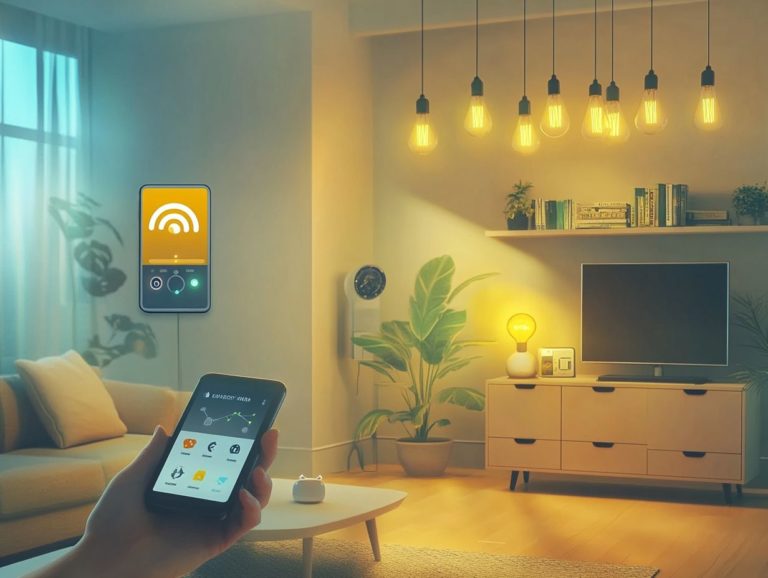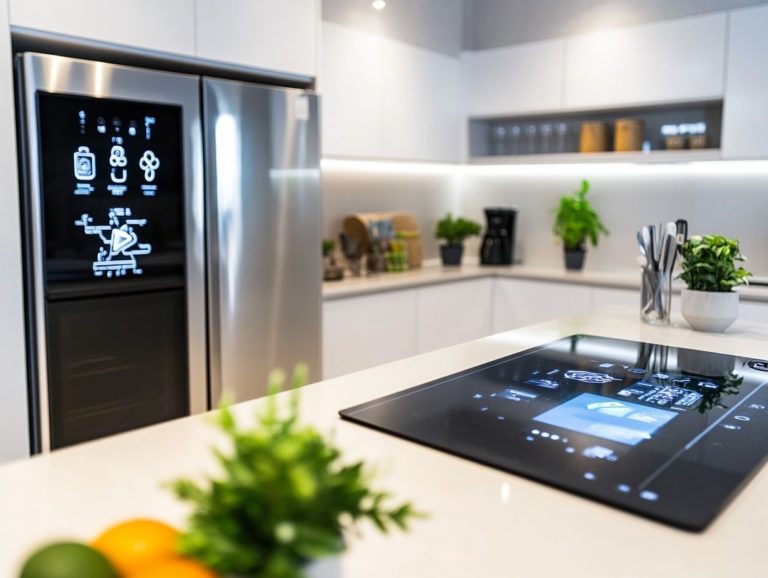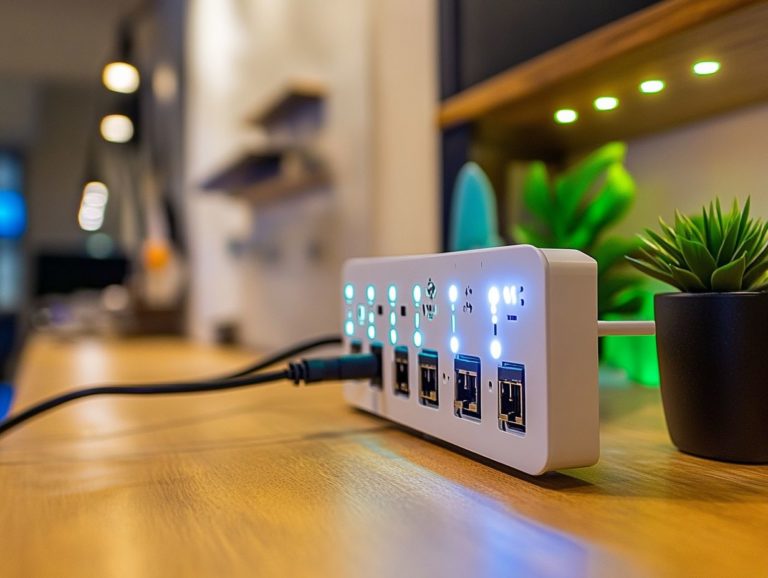The Basics of Smart Lighting Control
Smart lighting control systems revolutionize how you manage your home. They deliver convenience, energy efficiency, and customization to meet your needs.
This article explores what smart lighting control involves. You will discover important factors to consider before making your installation decision, including costs, compatibility, and how devices work with your existing setup.
You will also find a step-by-step guide for setup, including automation routines, along with tips to elevate your smart lighting experience. Get ready to light up your home smarter and more stylishly!
Contents
- Key Takeaways:
- Benefits of Smart Lighting Control
- Types of Smart Lighting Control Systems
- Factors to Consider Before Installing Smart Lighting Control
- Installation and Setup Process
- Tips for Maximizing the Use of Smart Lighting Control
- Frequently Asked Questions
- What is Smart Lighting Control?
- What are the benefits of using Smart Lighting Control?
- What types of devices can be used for Smart Lighting Control?
- Do I need to have a smart home system to use Smart Lighting Control?
- Is Smart Lighting Control difficult to install and set up?
- Can Smart Lighting Control be used for outdoor lighting?
Key Takeaways:

- Smart lighting control systems offer energy efficiency and convenience for users, making them a cost-effective option for home lighting needs.
- When considering smart lighting control, it’s important to think about cost, compatibility, and integration with other smart home devices.
- To maximize the benefits of smart lighting control, users can customize and automate their lighting preferences for a personalized experience.
What is Smart Lighting Control?
Smart lighting control is advanced technology that enables you to manage and customize your lighting experience. This innovative system includes smart bulbs, dimmable LED lights, and switches you can control easily.
It allows you to automate routines that align with your lifestyle adjusting brightness and the warmth or coolness of light to suit different scenarios throughout the day.
By integrating smart lighting with other devices, you can craft a more energy-efficient environment. Pairing lights with motion sensors makes them turn on automatically when you enter a room and switch off when you leave, ensuring energy conservation effortlessly.
Popular systems like Philips Hue offer great compatibility, letting you connect your lighting setups to various platforms, such as Samsung SmartThings and IFTTT. You can create personalized scenes for everything from cozy movie nights to elegant dinner parties.
Plus, smart lighting can adapt according to the time of day, enhancing your well-being by mimicking natural light patterns an easy way to elevate your mood and boost productivity.
Benefits of Smart Lighting Control
Smart lighting control offers incredible benefits beyond just convenience; they also improve energy efficiency and home security. This technology transforms your home into a smarter, more user-friendly haven.
By embracing smart bulbs, motion sensors, and programmable routines, you can seamlessly integrate lighting into your daily life while minimizing energy consumption.
Smart lighting allows you to create personalized schedules and automation that align perfectly with your lifestyle, even serving as an added layer of security by simulating occupancy when you’re not home.
Energy Efficiency and Convenience
Smart lighting systems boost energy efficiency and convenience in your home. They use smart devices to optimize energy use without sacrificing quality.
By utilizing smart bulbs, dimmable LEDs, and advanced light switches, you can take control of your lighting with just a tap or voice command. Adjust brightness and color temperature, including color-changing bulbs, to suit your specific needs.
This intelligent approach reduces utility bills and fosters a more sustainable living environment. It aligns perfectly with the rising trend of eco-friendly home systems.
With advanced features, smart lighting can track your energy consumption patterns and provide valuable insights. This enables you to make informed decisions about your usage. For instance, many systems allow you to set automated routines, ensuring that lights are only on when needed.
They can adjust based on room occupancy or even sync with natural daylight. This creates an ideal ambiance while conserving energy.
Managing your lights through mobile apps or voice commands offers unparalleled convenience. You can make adjustments even when you re on the move. Simple practices, like scheduling your lights to mimic occupancy when you re away, can further enhance energy efficiency.
This significantly curbs waste and promotes a greener lifestyle.
Types of Smart Lighting Control Systems
Choosing the right smart lighting system transforms your home into a modern oasis. Smart lighting control systems can be divided into wired and wireless options, each offering different features and benefits to cater to your specific needs.
Wireless systems, often utilizing technologies like Zigbee or Bluetooth, provide the flexibility of installation and compatibility with various smart home devices. Zigbee and Bluetooth are types of technologies that allow devices to communicate wirelessly.
On the other hand, wired systems deliver the stability of robust connections and a continuous power supply. Selecting the right system is crucial for enhancing your smart lighting experience and ensuring a seamless integration with your existing home automation setup.
Wireless vs. Wired Systems
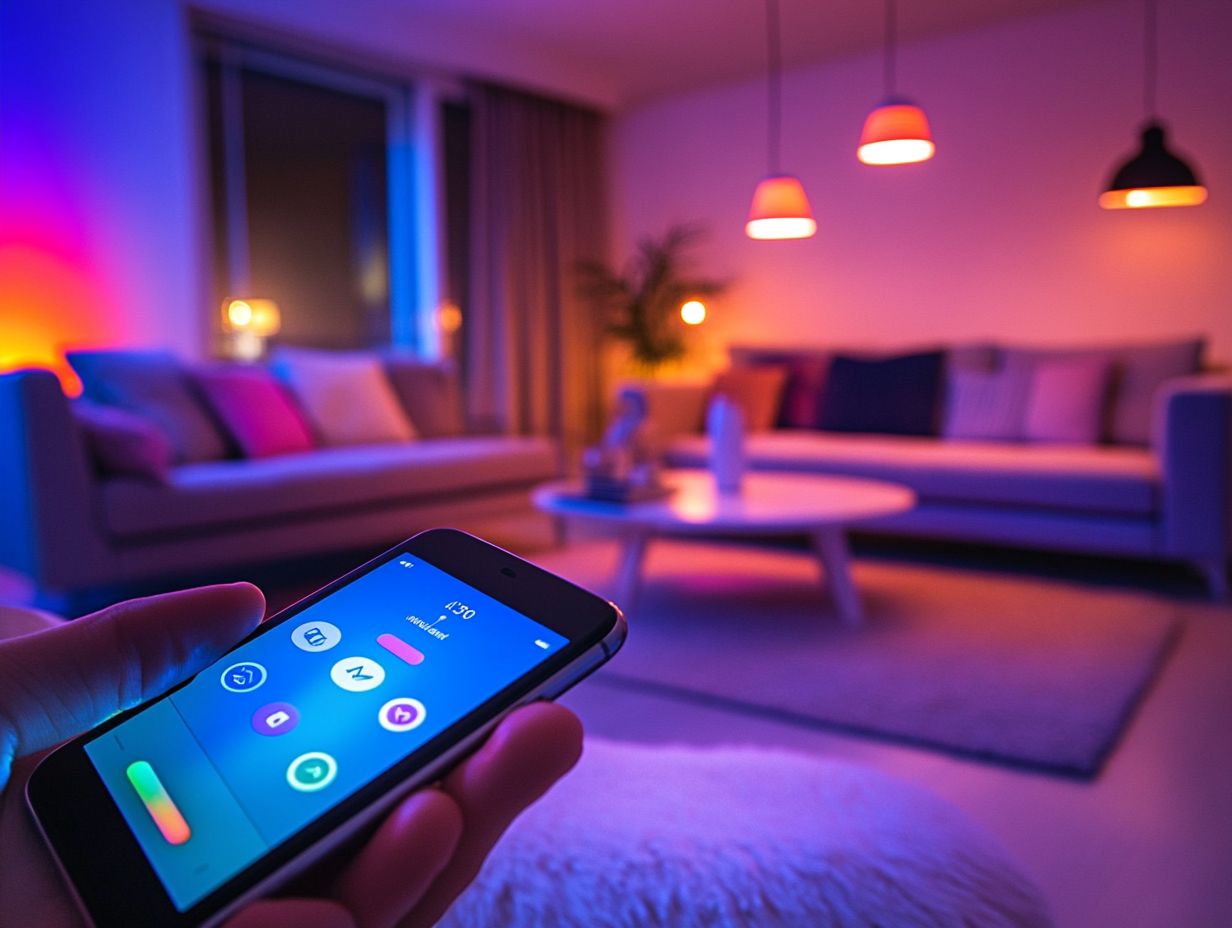
When weighing the options between wireless and wired smart lighting systems, it’s essential to understand their unique characteristics and how they shape your overall smart home experience.
Wireless systems, such as those powered by Zigbee or Bluetooth, provide the convenience of effortless installation and flexibility. This allows you to easily add or remove devices as your needs change.
In contrast, wired systems offer a more stable and reliable connection, which is particularly advantageous for larger homes or spaces that demand consistent performance from smart lighting applications.
Cost implications often play a significant role in your decision-making process. Wireless lighting can be more budget-friendly regarding installation costs since it typically avoids the need for extensive electrical work.
Consider the long-term compatibility with your existing smart home technologies as well. Wired systems often integrate seamlessly with established setups, ensuring robust performance over time.
As you make your choice, evaluate your unique needs. Think about the desired range, the complexity of integration, and whether you lean toward a DIY approach or prefer professional installation.
Individual vs. Group Control
Understanding the difference between individual and group control in smart lighting can enhance your experience at home. With individual control, you can manage specific lights or smart bulbs easily through an app or voice commands.
This includes adjusting brightness, color temperature, and on/off settings. On the other hand, group control allows you to manage multiple lights together. This makes it easy to create a unified lighting scene throughout your home, showcasing the benefits of smart lighting.
This control shines during gatherings. Set a lively ambiance with just a few taps, making smart home platforms work for you. You can set schedules to automate lighting transitions and create specific scenes for activities like movie nights or dinner parties.
These customizable lighting experiences enhance convenience and aesthetics. You can enjoy tailored atmospheres that maximize your smart environment.
Factors to Consider Before Installing Smart Lighting Control
Before installing a smart lighting control system, consider several key factors. First, assess your budget; costs can vary greatly based on features like app control and energy-saving options.
Next, think about compatibility. Make sure your chosen smart lighting works with existing devices like the Philips Hue bridge, Amazon Alexa, or Google Home for seamless integration.
Cost and Compatibility
Cost and compatibility are crucial factors in choosing smart lighting systems. The initial cost can vary based on features like brightness control and energy efficiency.
Ensure that the smart lighting devices you select are compatible with your current smart home devices. This will create an efficient smart home ecosystem.
Take time to research product specifications. Look into user reviews and expert recommendations for insights into reliability and performance.
Check compatibility with popular smart assistants like Amazon Alexa and Google Home. This will simplify your lighting control and boost your overall experience.
This thoughtful approach helps you create a smart lighting setup that meets your needs while maximizing your investment.
Integration with Other Smart Home Devices
Integrate smart lighting with other devices to boost your home s functionality. This creates a seamless environment that adapts to you.
By enabling smooth communication between smart bulbs, light switches, and motion sensors, along with appliances like smart thermostats and door locks, you can devise lighting schedules that genuinely elevate your living experience.
For instance, when connected to a smart thermostat, your smart lighting can adjust based on temperature changes, optimizing energy use while keeping you comfortable.
Linking your smart lights with home security systems allows the lights to flash or change colors whenever an alarm is triggered, providing a visual cue that enhances your overall security.
The versatility of these integrations not only boosts convenience but also contributes to energy efficiency, making them essential in modern home automation.
Installation and Setup Process
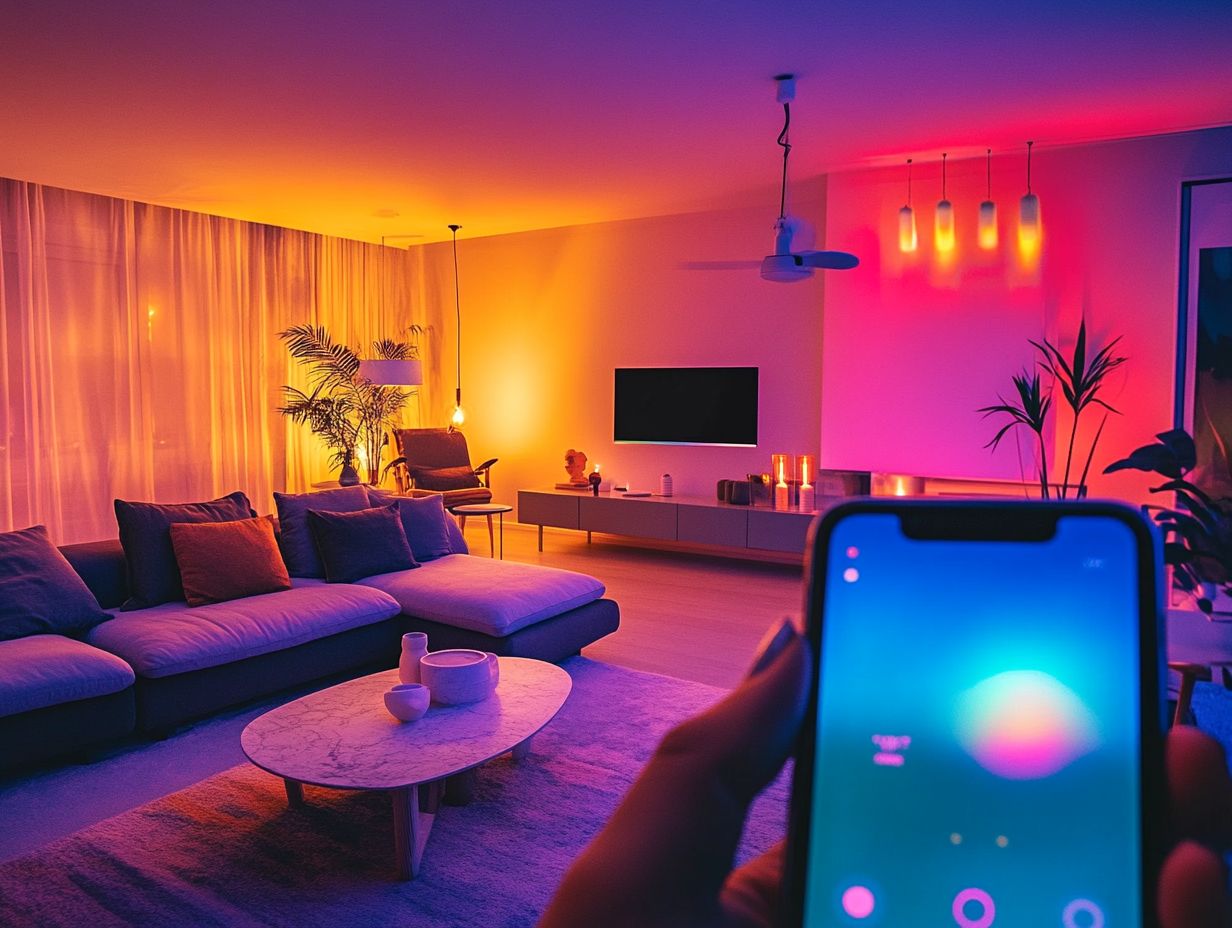
Installing smart lighting is straightforward. Choose either wired or wireless systems and follow these simple steps.
- Begin by selecting the right smart bulbs, switches, or LED strips that suit your aesthetic and functional preferences.
- Next, download the essential app for control and management.
- Once you establish a Bluetooth connection or use Zigbee (a wireless communication protocol for smart devices), you can configure your smart lighting system to connect with your existing smart home technology, automating various lighting scenarios.
Step-by-Step Guide
Follow this guide to install smart lighting easily. Start with selecting the right products for your needs, such as light sockets and smart plugs.
Before you dive into installation, explore the variety of smart lighting products on the market, including dimmable LED bulbs and Wi-Fi-enabled bulbs. To understand more about their advantages, check out the benefits of smart lighting solutions and assess which options best suit your lifestyle.
Once you’ve made your selections, ensure you turn off the power at the circuit breaker for safety. This is crucial when working with traditional switches and any smart home devices. Some light switches may require extra setup, while smart bulbs typically just need to be screwed in. To find the right fixtures, consider exploring the best smart lighting options for your home.
After securing the hardware, download the corresponding app for your smart light systems. These apps generally feature user-friendly interfaces for customizing brightness, color temperature, and scheduling.
Don t miss out on the scenes feature within the app. This allows you to create moods tailored to different times of the day, enhancing your circadian rhythm.
Tips for Maximizing the Use of Smart Lighting Control
Maximize smart lighting benefits with simple strategies. Adapt your lighting to fit your lifestyle, whether it’s movie night or a morning routine.
Leverage features like app control, voice commands, and integration with other smart home devices to craft a lighting experience that effortlessly adapts.
Fine-tuning color temperature and brightness according to the time of day can improve your circadian rhythm, contributing to your overall well-being and energy efficiency.
Customization and Automation
Customization and automation elevate smart lighting systems. They let you tailor your lighting experiences to fit your lifestyle and preferences.
Imagine the freedom of setting schedules and triggering actions using motion detectors. This simplifies your daily routine and boosts energy efficiency.
For instance, you could program your lights to gradually brighten in the morning using smart bulbs, mimicking a gentle sunrise for a soothing wake-up experience.
Compatibility with various devices, such as smart speakers and security systems, creates seamless integration. This forms a cohesive smart home ecosystem.
When hosting a movie night, you can effortlessly adjust the lighting to create a cozy ambiance with just a voice command or a simple tap on your smartphone app, enhancing the atmosphere.
Frequently Asked Questions
What is Smart Lighting Control?

Smart Lighting Control is a technology that allows users to remotely control their smart home lighting system through a smartphone, tablet, or other smart devices. It uses wireless communication to adjust lighting levels, turn lights on and off, and create customized schedules.
What are the benefits of using Smart Lighting Control?
Using Smart Lighting Control offers several benefits, including energy efficiency, convenience, and enhanced security. It can also improve the overall ambiance and mood of a space with customized lighting settings.
What types of devices can be used for Smart Lighting Control?
Smart Lighting Control can be accessed through various devices such as smartphones, tablets, voice assistants, and smart home hubs. Some systems also have dedicated controls or remotes.
Do I need to have a smart home system to use Smart Lighting Control?
No, you do not need a smart home system to use Smart Lighting Control. While some systems may integrate with smart home hubs, many can function as standalone devices, making them accessible to all users.
Is Smart Lighting Control difficult to install and set up?
No, most Smart Lighting Control systems are designed to be user-friendly and easy to install. Some may require professional installation, but many can be set up by the user with minimal effort.
Can Smart Lighting Control be used for outdoor lighting?
Yes, Smart Lighting Control can be used for both indoor and outdoor lighting. Some systems may have specific outdoor options, such as weather-resistant bulbs or sensors, ensuring proper functionality in outdoor environments.
Explore smart lighting options today and transform your space!




